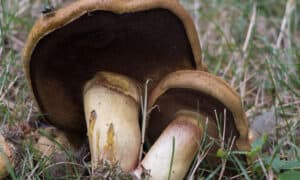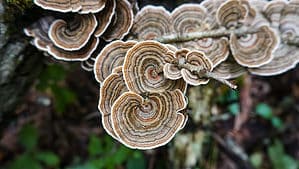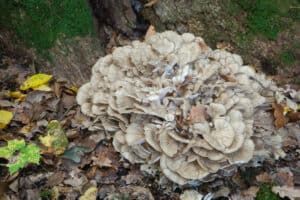If you enjoy mushroom foraging in the fall, you’re likely familiar with the honey mushroom, which is a delicious edible that appears in large clusters. However, it’s important to be familiar with a poisonous look-alike with a high toxicity status – skullcap mushrooms, also known as deadly skullcaps, autumn skullcaps, and deadly galerinas. We’ll use these common names interchangeably throughout the article.
In this guide, we’ll discuss the classification of deadly skullcap, how to identify it, how to distinguish it from edible honey mushrooms, where it grows, and what toxin it contains.
So, without further ado, let’s jump in!
Skullcap Mushrooms: Fungal Classification
Deadly skullcap mushrooms belong to the Hymenogastraceae family of mushrooms. Their genus is Galerina, and their Latin name is Galerina marginata. Prior to genetic analysis in 2001, Galerina autmnalis, Galerina oregonensis, Galerina unicolor, and Galerina venenata were all listed as separate species. However, we now know these are all, in fact, Galerina marginata.
Currently, modern mycology is able to use genetic sequencing to classify species more accurately than ever before. This means that as mycologists analyze fungi genomes, it’s not entirely uncommon for mushrooms once thought of as separate species to turn out to be genetically the same and for a mushroom classified as one species actually to be dozens of genetically distinct species. The best practice is to consult the most up-to-date information and cross-reference with reputable, expert sources when learning about wild mushrooms.
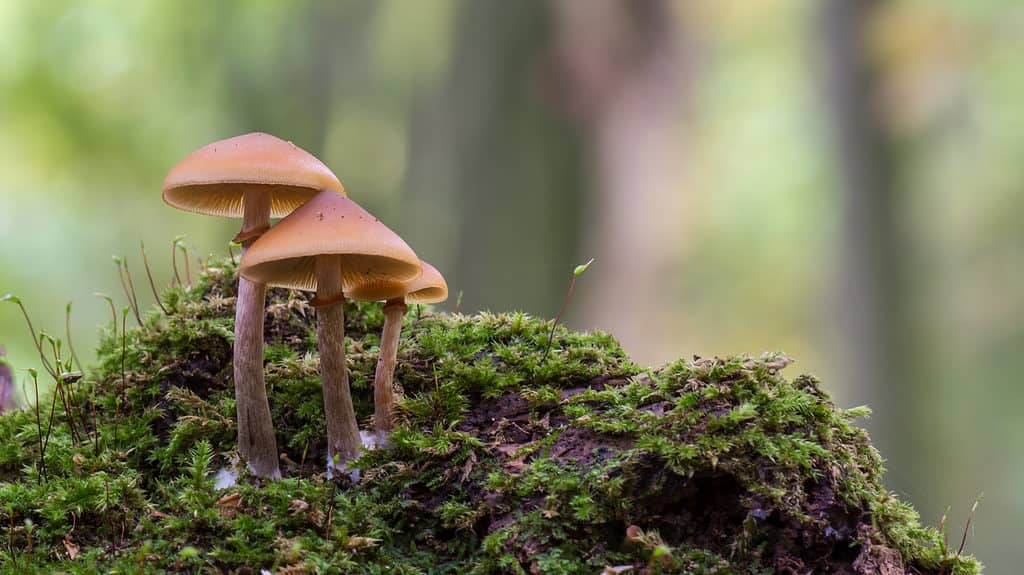
Deadly skullcaps (
Galerina marginata) are poisonous mushrooms which
typically grow in clusters on fallen hardwood and conifer logs.
©Jolanda Aalbers/Shutterstock.com
Ecology
While these mushrooms are poisonous to people, deadly skullcaps serve an important ecological niche as decomposers. As saprobic fungi, these mushrooms derive their nutrients from breaking down dead organic material. As they break down this material, they recycle and free up nutrients in the ground. This is absolutely essential for healthy, living soil and a healthy planet.
Galerina marginata typically grows in clusters on fallen hardwood and conifer logs. Sometimes they are found alone, but this is less common. These mushrooms exist across the Northern Hemisphere and can be found in North America, Europe, Asia, and, less commonly, Australia.
Usually, you can find deadly skullcaps flushing in larger numbers in the fall. But, they also flush in the spring and even in the winter months.
Deadly Skullcap Mushrooms: How to ID
So, most species of Galerina mushrooms are tiny and often fall in the “little brown mushroom” category. This phrase refers to the difficulty of identifying the thousands of species of small, non-distinct brown-capped fungi. However, deadly Galerina is a bit larger and more distinct than many of its relatives, making identifying it based on macroscopic (what you can see with the naked eye) features much more achievable.
The Cap
First, you’ll want to take a look at the cap of this mushroom. You should note a light honey-brown to a cinnamon-brown hue that can change as the mushroom matures. Aged specimens often have faded hues radiating out from the center of the cap. The cap is typically slightly slimy to sticky when wet but otherwise tacky to dry. The size of the cap can vary from 0.5 inches when young to 3.25 inches across at maturity. The shape of the cap starts out slightly bell to convex-shaped when young and expands to broadly convex to flat when mature.
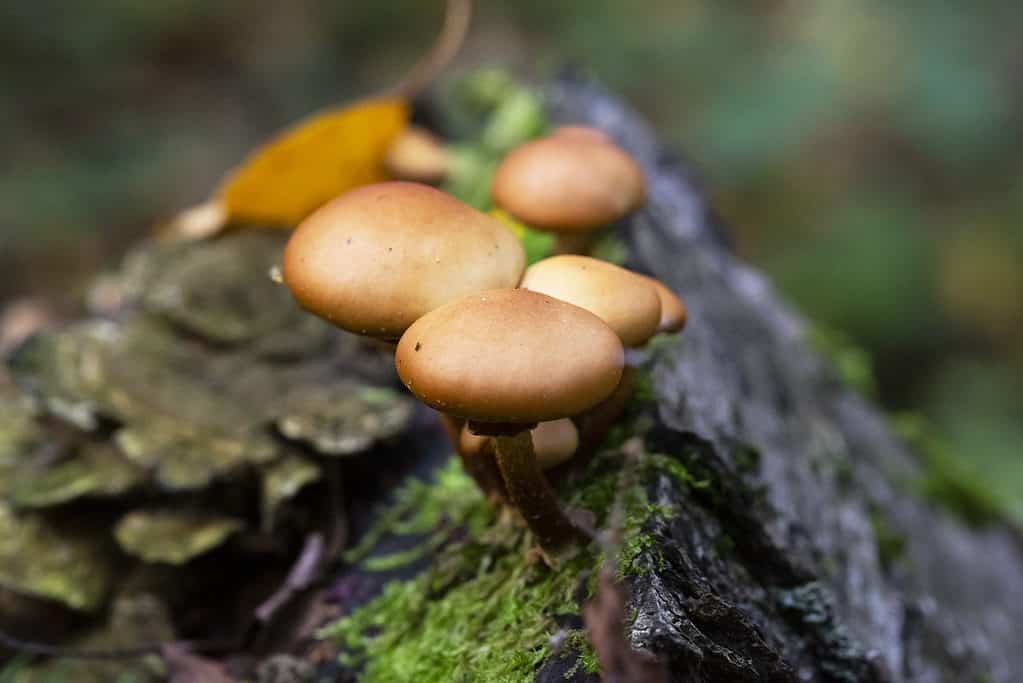
caps have a light honey-brown to cinnamon-brown hue that can change as the mushroom matures.
©iStock.com/Anna Nelidova
The Gills
Next, check out the gills of the specimen. The gills of the autumn skullcap are attached to the stipe and slightly subdecurrent (just barely starting to run down the stipe). These gills are not crowded, and start out honey-brown, turning to a darker rust-brown as the brown spores mature. When young, the gills are covered by an off-white partial veil. The spore print is rusty brown.
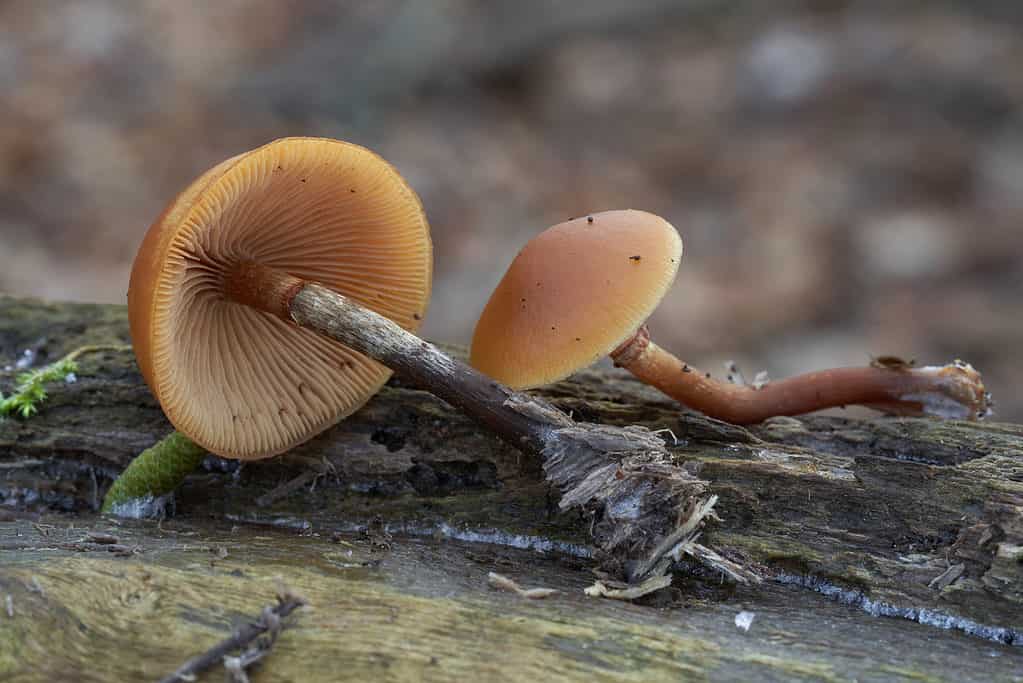
The gills of the autumn skullcap (deadly skullcap) mushroom is attached to and just barely run down the stipe.
©iStock.com/Igor Kramar
The Stipe
The stipe of the deadly skullcap is typically off-white on the upper portion of the stipe, becoming light brown towards the base. Stipes on aged specimens can turn more fully brown from the bottom up. The stipe contains a cream to light brown partial veil ring/skirt on the upper portion. Typically, the stipe reaches up to 3 inches long and about 1/3 of an inch wide.
The Inside
If you cut open an autumn skullcap, the flesh is a yellow-brown color and remains unchanged by exposure to oxygen. It is slightly mealy and easily crushed between the fingers.
What Poisonous Toxins Do Deadly Skullcap Mushrooms Contain?
As we noted above, deadly skullcap, as the common name suggests, contains a toxin that is highly poisonous to humans and pets such as dogs and cats. This mushroom contains amatoxins, which are heat-stable peptides that can not be destroyed through cooking and are the same toxins found in deadly amanita species, such as destroying angels.
The concentration of amatoxins in deadly galerinas is slightly less but comparable to the amount found in death caps (Amanita phalloides). These amatoxins are hepatotoxic, meaning they cause acute injury to the liver. Like destroying angels and death cap mushrooms, poisoning by Galerina marginata can lead to liver and kidney failure, coma, or death.
Initial signs and symptoms usually present 6-12 hours after ingestion and include persistent vomiting, diarrhea, dehydration, and abdominal cramps/pain. Signs of acute liver injury typically show up on blood work after 36 hours. Depending on the amount ingested, and the timeline of medical intervention, poisoning can progress to liver and kidney failure or death. If Galerina marginata poisoning is suspected, head to the emergency room and bring a sample of the mushroom with you if possible.
How to Distinguish Deadly Skullcap Mushrooms from Edible Honey Mushrooms
In the fall, across temperate regions of the Northern Hemisphere, foragers go out collecting baskets full of the delicious ringed honey mushroom, Armillaria mellea. This species of honey mushroom can be easily confused by inexperienced foragers with deadly skullcaps. However, there are some clear distinctions between honeys and autumn galerinas that will help you confirm the mushroom’s identity.
Note that both of these mushrooms are saprobic on hardwood and conifer logs (although honeys can also be parasitic on live trees), flush in the fall, and can occur in the same regions. So identifying based on macroscopic features and spore prints is vitally important. Of course, when in doubt, throw it out, and it’s always best to practice your foraging journey under the guidance of a mushroom expert.
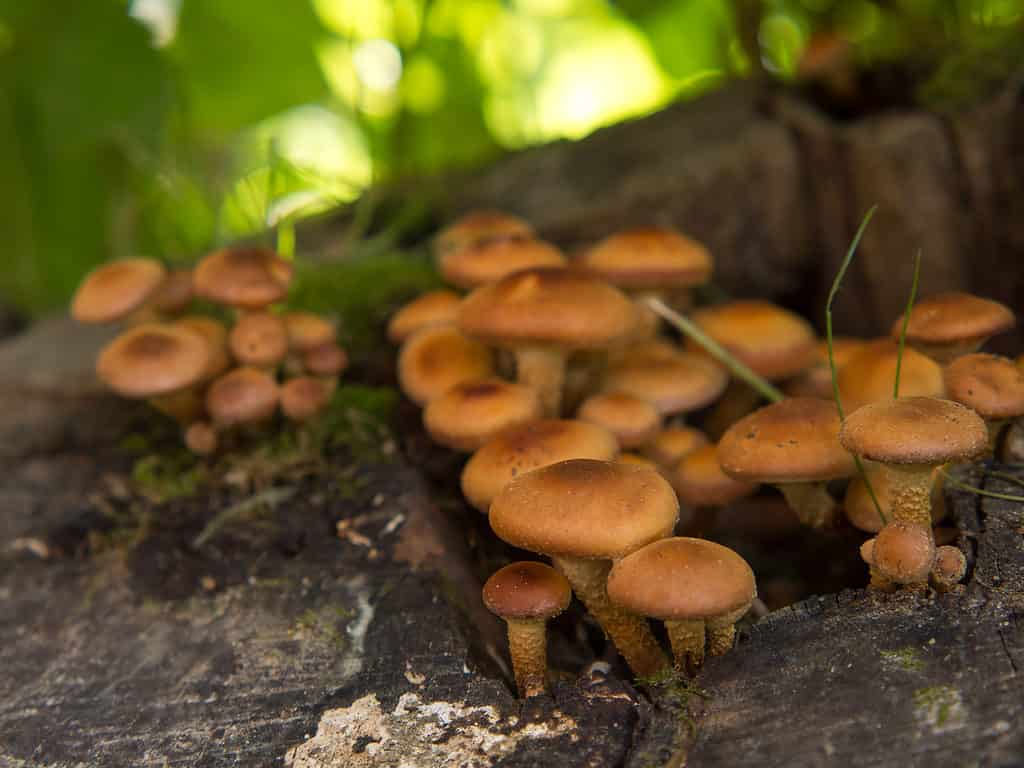
(honey mushrooms) can be easily confused by inexperienced foragers with deadly skullcaps.
©iStock.com/maksim kulikov
Comparing Caps
At first glance, the caps of honey mushrooms can look strikingly similar to deadly galerinas. Honey caps are golden-yellow when young, becoming paler brown with age, often with faded spots on the center. The caps are typically dotted with fine dark yellow-brown scales. Note that deadly skullcaps do not feature this scaling on the cap. Young specimens have a tightly convex cap that expands to broadly convex to flat when mature. Note that the caps of honeys grow larger than deadly galerinas, with a max cap width of 5 inches.
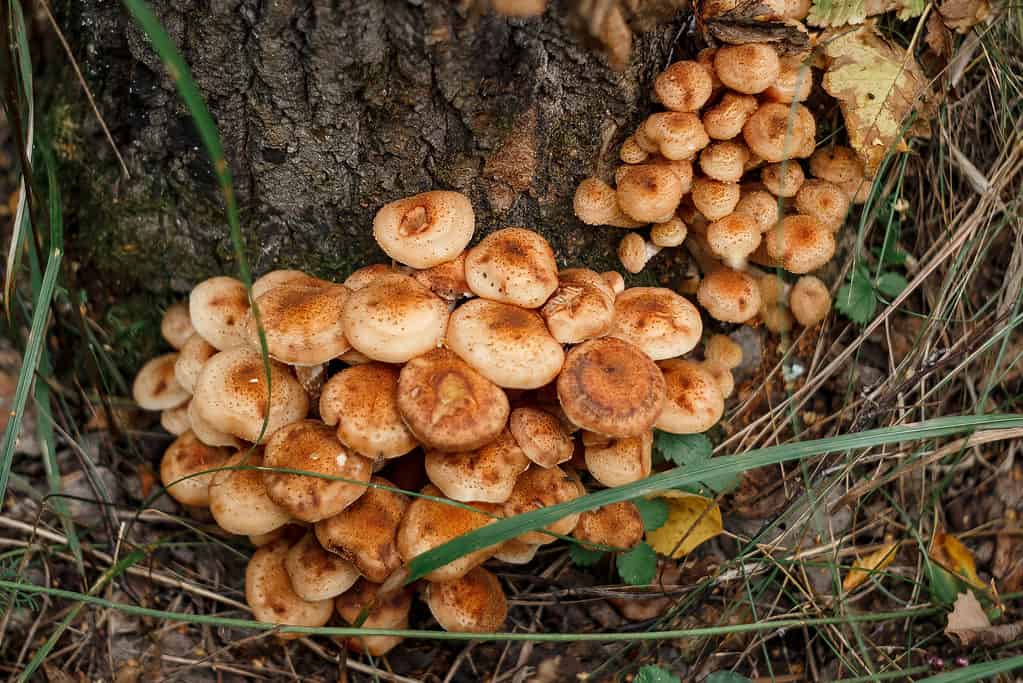
Honey mushroom caps often have faded spots on the center and dotting of fine dark yellow-brown scales that deadly skullcaps do not have.
©Roman Milavin/Shutterstock.com
Comparing Gills
Like autumn skullcaps, young honey mushroom gills are covered by a partial veil. However, the partial veil of honey is white rather than light brown. The gills of honey are also cream to white and much closer than that of the brown-gilled deadly skullcaps. The spores of Armillaria mellea are also white, compared to the rusty brown spores of Galerina marginata.
Comparing Stipes
The stipe of honey mushrooms is typically much lighter than that of deadly skullcap and grows longer and thicker. Note that the stipe of Armillaria mellea can reach up to 8 inches long and 3/4 of an inch thick. Like the autumn skullcap, mature specimens of Armillaria mellea have a partial veil ring around the upper portion of the stipe. However, this ring is off-white colored rather than light brown.
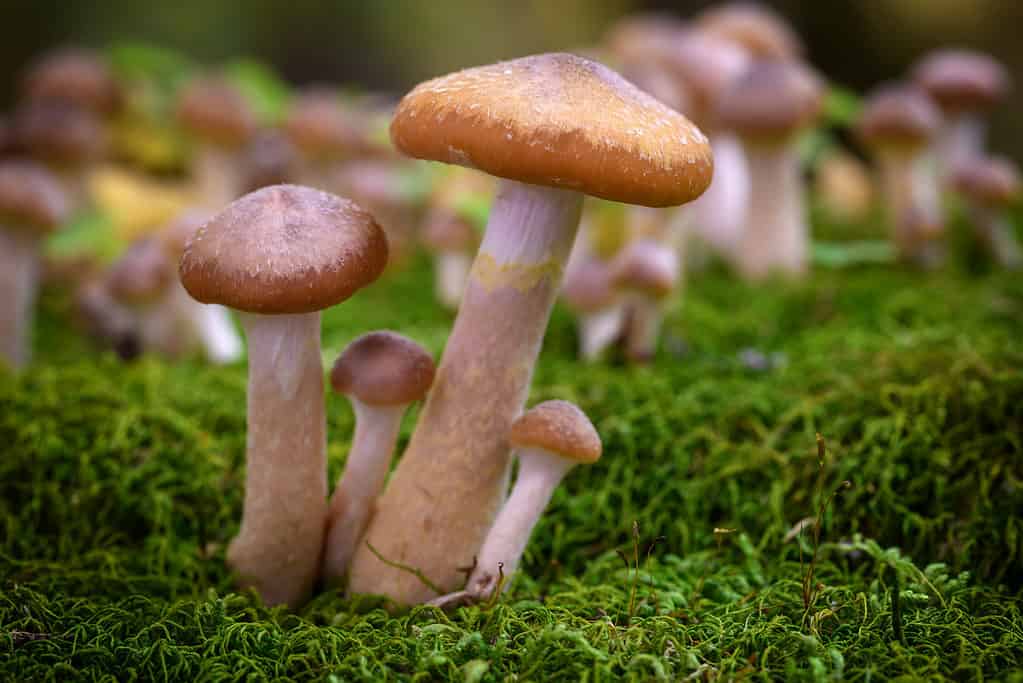
The stipe of honey mushrooms is typically much lighter than that of deadly skullcap and grows longer and thicker.
©Zbigniew Dziok/Shutterstock.com
Compare the Insides
While the flesh of the deadly skullcap is yellow to light brown, the flesh of Armillaria mellea is white to off-white. Note that the flesh of both of these mushrooms does not bruise or change colors when exposed to oxygen.
The photo featured at the top of this post is © iStock.com/Alika Obrazovskaya
The information presented on or through the Website is made available solely for general informational purposes. We do not warrant the accuracy, completeness, or usefulness of this information. Any reliance you place on such information is strictly at your own risk. We disclaim all liability and responsibility arising from any reliance placed on such materials by you or any other visitor to the Website, or by anyone who may be informed of any of its contents. None of the statements or claims on the Website should be taken as medical advice, health advice, or as confirmation that a plant, fungus, or other item is safe for consumption or will provide any health benefits. Anyone considering the health benefits of particular plant, fungus, or other item should first consult with a doctor or other medical professional. The statements made within this Website have not been evaluated by the Food and Drug Administration. These statements are not intended to diagnose, treat, cure or prevent any disease.
Sources
- MushroomExpert.com, Available here: https://www.mushroomexpert.com/galerina_marginata.html
- Akata I, Yilmaz I, Kaya E, Coskun NC, Donmez M. Toxin components and toxicological importance of Galerina marginata from Turkey. Toxicon. 2020 Nov;187:29-34. doi: 10.1016/j.toxicon.2020.08.017. Epub 2020 Aug 28. PMID: 32866473., Available here: https://pubmed.ncbi.nlm.nih.gov/32866473/
- Beaty Biodiversity Museum, Available here: https://explore.beatymuseum.ubc.ca/mushroomsup/G_marginata.html
- MushroomExpert.com, Available here: https://www.mushroomexpert.com/armillaria_mellea.html
Thank you for reading! Have some feedback for us? Contact the AZ Animals editorial team.



